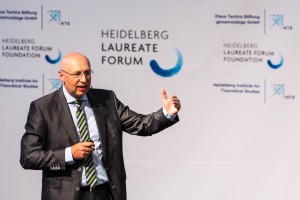Stefan Hell and the Difficult Task of Communicating Science
BLOG: Heidelberg Laureate Forum

It turns out that the idea behind the Heidelberg Laureate Forum isn’t exactly new. In fact, Nobel laureates and young scientists have been meeting in Lindau for more than 50 years, and it is these events that HLF is modelled on. For the first time, to show the strong affiliation between the events, we have a Nobel laureate speaking at HLF, and a laureate from HLF will speak at the next Lindau meeting.
This year, we were honoured to hear from Stefan Hell, Nobel Laureate in Chemistry 2014. His talk was part life story, and part description of the breakthrough that lead to the Nobel Prize. I personally found both aspects equally compelling, but the thing that Hell succeeded at most was managing to communicate his scientific work in a way we, decidedly not chemists, could understand.

Some of my friends and colleagues know that I am very picky about presentations. I find that many talks, especially research talks in conferences, could be so much better. Slides are best used as a prop, not notes. The talk should tell a story of sorts, and not be structured the same way as a paper (written and oral forms of communication just don’t work the same way). The content should be clear for audiences outside the direct field of the speaker, yet detailed enough for those who are part of it. And, of course, the speaker should be personable and engaging.
Stefan Hell succeeded on all counts with his excellent lecture.
Hell’s work makes it possible to view molecules at a much higher resolution than previously possible. The key insight that made this possible was the realization that you can never get better resolution by focusing light – there is no way to focus a lens to a point small enough. Instead, his work showed that you can put molecules into two different states and show only a small number of them in one of those states. I was thrilled to understand as he walked us through the key ideas, despite the fact that I haven’t done chemistry or physics since my first year of undergrad.
If you want to see for yourself, you can watch Hell’s Lindau lecture online. See also the HLF Blog post on whether Hell should be considered a role model for mathematicians, and read about STED microscopy on Wikipedia.

